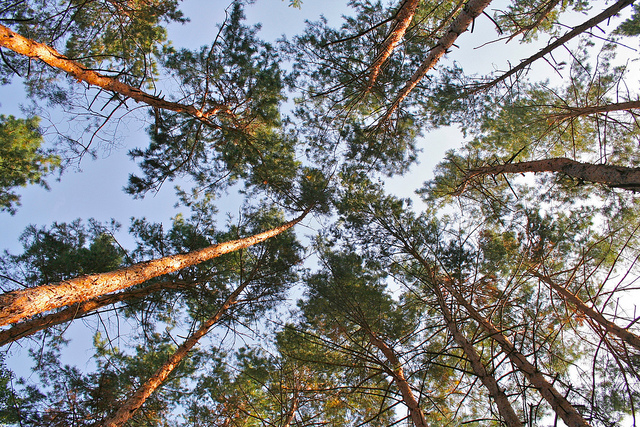UC Santa Cruz music professor David Dunn has joined forces with two forest scientists from Northern Arizona University to combat an insect infestation that is killing millions of trees throughout the West.
They are applying the results of nearly a decade of acoustic research in an unconventional collaborative effort to stop bark beetles from tunneling through the living tissue of weakened, drought-stressed pine trees.
The trio has now received a patent for a device that uses sound as a targeted sonic weapon to disrupt the feeding, communication, reproduction, and various other essential behaviors of the insects.
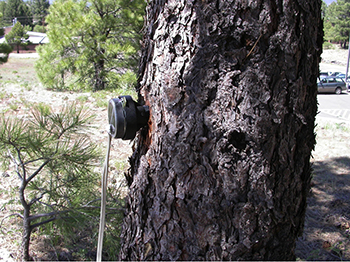
Dunn explained how this research came about.
“When massive tree death started occurring in Northern New Mexico where I was living, I became curious if there were sounds associated with such a large amount of biological activity,” said Dunn.
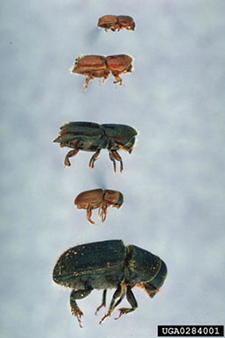
“At that time there was still the assumption that this was the result of a local bark beetle infestation due to drought conditions. Since then, we have come to realize that this was not just a local outbreak but one of many outbreaks across all of the western states and Canadian provinces that has been driven by climate change conditions. Many scientists think that we are experiencing the largest insect infestation of North America in the fossil record of the Earth,” he added.

Dunn spent a few weeks thinking about how to listen to the interior of trees and soon came up with a simple listening device that cost less than $10 to build. Designing unique and inexpensive devices in order to listen to sound had long been a part of his artistic work.
“After making hundreds of hours of recordings inside hundreds of trees, I made a large sound composition that represented the incredible diversity of sounds made by a couple of species of bark beetles and their changing responses to the life cycle of tree hosts that they invade,” said Dunn. “This was released as a CD (The Sound of Light in Trees) that garnered a lot of attention from both the sound, art, and music community, as well as various scientists involved in bio-acoustic research.”
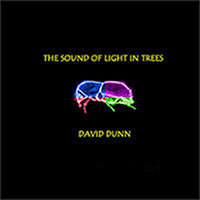
“After that interest emerged, I was approached by my future colleagues at Northern Arizona University who not only wanted to replicate what I had done, but to collaborate on how to push this research further. These further results led to the device and protocol that we have just patented.”
Dunn noted that it is very unusual for a scientific patent to be awarded to an artist and added that there are very few examples of concrete results from collaborations between artists and scientists.
“My contribution to the project mostly concerned the technical design aspects of the audio, electronic circuit designs, and the novel sound gathering techniques,” Dunn explained. “In a very real sense, this represented a kind of reverse “tech transfer” from the arts to the sciences. Historically, it has usually been the other way around.”
“We have now entered into a period of common interests between art and science largely driven by the commonality of digital tools,” Dunn added.
“Artists are now just as involved in designing such tools as the scientific community and often create software and instrumentation in order to facilitate their creative visions that may ultimately be of even greater value to scientific research. I think that this was one of those instances and a couple of fortuitous events conspired to allow something interesting to happen.”
Dunn observed that one important aspect of art/science collaborations is the peculiar ability of artists to trust their imagination over their rational faculty.
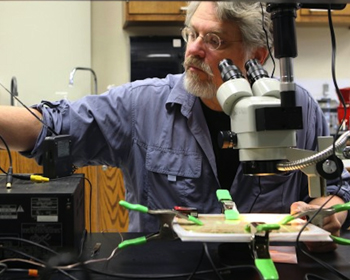
“Most of the best scientists I know have fantastic and expansive imaginative capacities but often have to strategically mask those skills in order to operate within disciplinary and professional constraints,” said Dunn. “I personally believe that science must be a deeply rigorous enterprise, but it is not an either/or issue. It is the balance between the rational and imaginative that will ultimately solve the most serious problems that threaten us.”
“Artists can sometimes ask the pithy or embarrassing question that needs to be asked, or cuts across disciplinary constraints, or politics, without paying a professional price. As Gregory Bateson, a former faculty member of UC Santa Cruz put it: ‘rigor alone is paralytic death, imagination alone is insanity.’”
Dunn said that he and his colleagues at Northern Arizona University—Richard Hofstetter and Reagan McGuire–hope to produce a range of products as a result of their patent to combat bark beetles, as well as other insects related to them.
He added that scaling up the device to be effective in saving large forests might be possible through the use of local wireless or FM broadcast to protect select areas of forest, depending on how cheaply they can produce an effective system that can be applied to individual trees.
“One major obstacle is the issue of how to miniaturize the analog circuits and sample playback,” said Dunn. “One of my brilliant graduate students, David Kant in music, has been working on putting all of this into digital form and has largely succeeded. If we can solve that problem and come up with viable output transducers, amplification, and solar power solutions, it’s very doable.”
Source: UCSC.edu
Women of Green is TURNING UP THE VOLUME of the feminine voice on the planet in order to create the world we know is possible.
